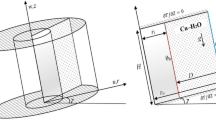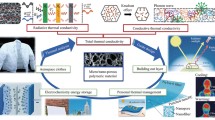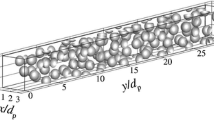Abstract
Yttria-stabilized zirconia (YSZ) is widely used as thermal barrier coatings (TBCs) to reduce heat transfer between hot gases and metallic components in gas-turbine engines. Porous structure can generally reduce the lattice thermal conductivity of bulk material, so porous YSZ can be potentially used as TBCs with better thermal performance. In this work, we investigate the thermal conductivity of nanoporous YSZ using the nonequilibrium molecular dynamics (NEMD) simulation, and comprehensively discuss the effects of cross-sectional area, pore size, structure length, porosity, Y2O3 concentration and temperature on the thermal conductivity. To compare with the results of the NEMD simulation, we solve the heat diffusion equation and the gray Boltzmann transport equation (BTE) to calculate the thermal conductivity of the same porous structure. From the results, we find that the thermal conductivity of YSZ has a weak dependence on the structure length at the length range from 10 to 26 nm, which indicates that the majority of heat carriers have very short mean free path (MFP) but there exists small percentage (about 3%) of phonons with longer MFP (larger than 10 nm) contributing to the thermal conductivity. The thermal conductivity predicted by NEMD simulation is smaller than that of solving heat diffusion equation (diffusive limit) with the same porous structure. It shows that the presence of pores affects phonon scattering and further affects the thermal conductivity of nanoporous YSZ. The results agree well with the solution of gray BTE with a average MFP of 0.6 nm. The thermal conductivity of nanoporous YSZ weakly depends on the Y2O3 concentration and temperature, which shows the phonons with very short MFP play the major contribution to the thermal conductivity. The results help to better understand the heat transfer in porous YSZ structure and develop better TBCs.
Similar content being viewed by others
References
PADTURE N P, GELL M, JORDAN E H. Thermal barrier coatings for gas-turbine engine applications [J]. Science, 2002, 296(5566): 280–284.
CAO X Q, VASSEN R, STOEVER D. Ceramic materials for thermal barrier coatings [J]. Journal of the European Ceramic Society, 2004, 24(1): 1–10.
NATH S, MANNA I, MAJUMDAR J D. Nanomechanical behavior of yttria stabilized zirconia (YSZ) based thermal barrier coating [J]. Ceramics International, 2015, 41(4): 5247–5256.
NAIT-ALI B, HABERKO K, VESTEGHEM H, et al. Thermal conductivity of highly porous zirconia [J]. Journal of the European Ceramic Society, 2006, 26(16): 3567–3574.
PIA G, CASNEDI L, SANNA U. Porosity and pore size distribution influence on thermal conductivity of yttria-stabilized zirconia: Experimental findings and model predictions [J]. Ceramics International, 2016, 42(5): 5802–5809.
SCHLICHTING K W, PADTURE N P, KLEMENS P G. Thermal conductivity of dense and porous yttriastabilized zirconia [J]. Journal of Materials Science, 2001, 36(12): 3003–3010.
PIA G. High porous yttria-stabilized zirconia with aligned pore channels: Morphology directionality influence on heat transfer [J]. Ceramics International, 2016, 42(10): 11674–11681.
NAN C W, BIRRINGER R, CLARKE D R, et al. Effective thermal conductivity of particulate composites with interfacial thermal resistance [J]. Journal of Applied Physics, 1997, 81(10): 6692–6699.
BOURRET J, TESSIER-DOYEN N, NAIT-ALI B, et al. Effect of the pore volume fraction on the thermal conductivity and mechanical properties of kaolin-based foams [J]. Journal of the European Ceramic Society, 2013, 33(9): 1487–1495.
CHUNG J D, KAVIANY M. Effects of phonon pore scattering and pore randomness on effective conductivity of porous silicon [J]. International Journal of Heat and Mass Transfer, 2000, 43(4): 521–538.
HSIEH T Y, LIN H, HSIEH T J, et al. Thermal conductivity modeling of periodic porous silicon with aligned cylindrical pores [J]. Journal of Applied Physics, 2012, 111(12): 124329.
WANG M, PAN N. Modeling and prediction of the effective thermal conductivity of random open-cell porous foams [J]. International Journal of Heat and Mass Transfer, 2008, 51(5/6): 1325–1331.
WANG M, WANG J, PAN N, et al. Three-dimensional effect on the effective thermal conductivity of porous media [J]. Journal of Physics D: Applied Physics, 2006, 40(1): 260.
GUO Y, WANG M. Lattice Boltzmann modeling of phonon transport [J]. Journal of Computational Physics, 2016, 315: 1–15.
LEE J H, GALLI G A, GROSSMAN J C. Nanoporous Si as an efficient thermoelectric material [J]. Nano Letters, 2008, 8(11): 3750–3754.
HE Y, DONADIO D, LEE J H, et al. Thermal transport in nanoporous silicon: Interplay between disorder at mesoscopic and atomic scales [J]. ACS Nano, 2011, 5(3): 1839–1844.
LAU K C, DUNLAP B I. Molecular dynamics simulation of yttria-stabilized zirconia (YSZ) crystalline and amorphous solids [J]. Journal of Physics: Condensed Matter, 2011, 23(3): 035401.
FREEMAN J J, ANDERSON A C. Thermal conductivity of amorphous solids [J]. Physical Review B, 1986, 34(8): 5684.
HE Y, DONADIO D, GALLI G. Morphology and temperature dependence of the thermal conductivity of nanoporous SiGe [J]. Nano Letters, 2011, 11(9): 3608–3611.
ZHOU XW, JONES R E. Effects of nano-void density, size and spatial population on thermal conductivity: A case study of GaN crystal [J]. Journal of Physics: Condensed Matter, 2012, 24(32): 325804.
BRINKMAN H W, BRIELS W J, VERWEIJ H. Molecular dynamics simulations of yttriastabilized zirconia [J]. Chemical Physics Letters, 1995, 247(4/5/6): 386–390.
SCHELLING P K, PHILLPOT S R. Mechanism of thermal transport in zirconia and yttria-stabilized zirconia by molecular-dynamics simulation [J]. Journal of the American Ceramic Society, 2001, 84(12): 2997–3007.
CARSON J K, LOVATT S J, TANNER D J, et al. An analysis of the influence of material structure on the effective thermal conductivity of theoretical porous materials using finite element simulations [J]. International Journal of Refrigeration, 2003, 26(8): 873–880.
MURTHY J Y, MATHUR S R. Computation of submicron thermal transport using an unstructured finite volume method [J]. Journal of Heat Transfer, 2002, 124(6): 1176–1181.
TIAN Z, HU H, SUN Y. A molecular dynamics study of effective thermal conductivity in nanocomposites [J]. International Journal of Heat and Mass Transfer, 2013, 61: 577–582.
PLIMPTON S. Fast parallel algorithms for shortrange molecular dynamics [J]. Journal of Computational Physics, 1995, 117(1): 1–19.
VAN BEEST B W H, KRAMER G J, VAN SANTEN R A. Force fields for silicas and aluminophosphates based on ab initio calculations [J]. Physical Review Letters, 1990, 64: 1955.
ALDEBERT P, TRAVERSE J P. Structure and ionic mobility of zirconia at high temperature [J]. Journal of the American Ceramic Society, 1985, 68(1): 34–40.
MINERVINI L, GRIMES R W, SICKAFUS K E. Disorder in pyrochlore oxides [J]. Journal of the American Ceramic Society, 2000, 83(8): 1873–1878.
SCHELLING P K, PHILLPOT S R, KEBLINSKI P. Comparison of atomic-level simulation methods for computing thermal conductivity [J]. Physical Review B, 2002, 65(14): 144306.
LUKES J R, TIEN C L. Molecular dynamics simulation of thermal conduction in nanoporous thin films [J]. Microscale Thermophysical Engineering, 2004, 8(4): 341–359.
ZHANG X, BAO H, HU M. Bilateral substrate effect on the thermal conductivity of two-dimensional silicon [J]. Nanoscale, 2015, 7(14): 6014–6022.
Acknowledgement
Simulations were performed with computing resources granted by the High Performance Computing Center at Shanghai Jiao Tong University.
Author information
Authors and Affiliations
Corresponding author
Additional information
Foundation item: the National Natural Science Foundation of China (No. 51676121)
Rights and permissions
About this article
Cite this article
Zhao, S., Shao, C., Zahiri, S. et al. Thermal Transport in Nanoporous Yttria-Stabilized Zirconia by Molecular Dynamics Simulation. J. Shanghai Jiaotong Univ. (Sci.) 23, 38–44 (2018). https://doi.org/10.1007/s12204-018-1907-z
Received:
Published:
Issue Date:
DOI: https://doi.org/10.1007/s12204-018-1907-z
Key words
- thermal conductivity
- nanoporous
- molecular dynamics
- mean free path (MFP)
- yttria-stabilized zirconia (YSZ)




